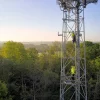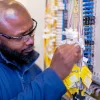Ofcom Sets Guidance to Improve Resilience of UK Broadband and Mobile Networks UPDATE

The UK telecoms and media regulator, Ofcom, has today set out how they intend to update their guidance on network resilience in order to give broadband ISPs, mobile operators and other digital network providers greater clarity on how they can “reduce the risk of network outages“. But proposals to improve battery backup on mobile networks will come later.
Communications providers in the UK currently have a legal obligation to identify, prepare for and reduce the risk of anything that compromises the availability, performance or functionality of their networks. But such networks are highly complex and outages can still occur, with Ofcom warning that the consequences of these are “likely to become more severe as society becomes increasingly dependent on them to function.”
In response, the regulator plans to update their existing resilience guidance to provide greater clarity on how providers of public electronic communications networks and services (PECN and PECS) can comply with their security duties under a new framework for security and resilience, which originally came into force in October 2022.
Advertisement
Network providers are now expected to have regard to the New Network and Service Resilience Guidance when considering their resilience-related security duties. The hope is that this may reduce the chances of serious and protracted network outages occurring (e.g. last year’s BT outage of 999 services) or make them quicker to resolve. But modern networks are complex beasts that can fail due to all sorts of reasons (it’s often the ones you don’t foresee or expect that bite the hardest).
What Ofcom have decided – in brief
We are introducing an updated version of our resilience guidance for providers of PECN/S, which sets out measures we expect them to take in relation to the resilience of their networks and services as part of their security duties imposed by and under s105A-D of the Communications Act 2003.
These measures include:
• ensuring that networks are designed to avoid or reduce single points of failure;
• ensuring that key infrastructure points have automatic failover functionality built in so that when equipment fails, network traffic is immediately diverted to another device or site that can maintain end user connectivity;
• setting out the processes, tools, and training that should be considered to support the requirements on resilience.
The issue of power backup was also considered, although for now Ofcom has only chosen to recommend that electrical power provision at each “core site” should include the following: “Battery backup and fuel-powered electricity generators. These sites are expected to be able to survive power loss for a minimum of 5 days, with permanent electricity generators on site which can be refuelled while in operation.”
The regulator had also considered the potential for requiring a 4-hour power backup in active cabinets on fixed line broadband networks (some operators already target 3-4 hours), but the final guidance noted significant concerns over the “nature and scale of costs needed to retrospectively upgrade active street cabinets.”
Ofcom Statement on Power Backup (Active Cabinets)
Assessing the capability of existing networks to meet the proposed 4-hour minimum requirement may be challenging and may vary significantly between providers. This uncertainty extends to the potential cost implications for providers of retrospectively upgrading their active cabinets to achieve this specific target. Based on the evidence now available, we cannot be confident that including such a specific measure, a minimum 4-hour backup power supply that extends to all existing powered active components in street cabinets, would be a proportionate measure within the guidance.
However, the final guidance does still include a soft recommendation, rather than a hard requirement: “Based on the factors above, we would consider power backup of approximately four hours to be good practice for active fixed access equipment in cabinets at the point of installation. In areas that suffer longer power outages more frequently, we would expect CPs to increase the duration of power backup as appropriate.”
Advertisement
The original consultation on all of this was also accompanied by a separate Call for Input (CFI) on the potential for improving power backup for mobile radio access networks (RAN), such as at the mast sites operated by Three UK, EE, Vodafone and O2. But we recently reported on how many mobile operators had balked at the costs of deploying national battery backup (here).
For example, their CFI asked questions about the feasibility of mobile operators installing a minimum 1 hour of battery backup on RAN sites. But Ofcom’s own illustrative example suggested that to install this on RAN sites, where power backup is likely to be feasible, could cost in the region of £0.9 – £1.8bn (this would end up being passed on to consumers as higher prices). Due to this, the regulator didn’t consider it “proportionate” to include such a measure in their future guidance “at this stage“, but they did seem to be hinting at a move in that direction.
Ofcom’s Response to the CFI (Battery Backup)
While the feedback showed strong interest in mobile resilience, some highlighted the need for a broader approach to power backup beyond the telecoms sector. Additionally, responses offered valuable insights into potential harms from power outages, such as the effect on emergency services and communication difficulties, particularly in rural areas where communities could be more vulnerable to the impacts of outages.
Over the coming months, we will further analyse the information gathered to determine if additional resilience measures are needed for the mobile RAN. This analysis will consider a range of solutions, rather than a one-size-fits-all approach, and we plan to work with government and industry to identify the most suitable way forward.
Suffice to say that we’ll have to wait a bit longer before Ofcom decides on its position with respect to battery backup at mobile sites, although they’ve already largely ruled out imposing a strict time requirement. The expectation we have is that the regulator will end up taking a more targeted and mixed-solutions approach (e.g. a focus on rural sites), which may also need support from other sectors (e.g. energy) in order to be effective.
UPDATE 9th Sept 2024
Advertisement
We’ve had a comment from fibre network operator Zayo Europe.
Michael Katz, VP for Product & Technology at Zayo Europe, said:
“Network resiliency has become mandatory rather than a luxury, and Ofcom’s updated guidance is welcome. But building resilient networks is vastly easier said than done. Accurate network records are a major impediment to this, and many network operators still don’t have a good understanding of their network assets. This lack of transparency causes delays in network planning and delivery as well as increased cost and uncertainty. It also makes it near impossible for alternative telecom service providers to accurately plan network resiliency.
At Zayo Europe, we share network KMZ files with our telecom service provider customers, so they know precisely where their fibre runs. We offer multiple exit points from the UK to both Europe and the US, including direct, long haul and deep subsea routes that, together, provide the diversity our customers need. As a result of this culture of excellence, our network availability is at 99.992%.”
Mark is a professional technology writer, IT consultant and computer engineer from Dorset (England), he also founded ISPreview in 1999 and enjoys analysing the latest telecoms and broadband developments. Find me on X (Twitter), Mastodon, Facebook, BlueSky, Threads.net and Linkedin.
« Virgin Media UK Adds Support for Rakuten TV Streaming App





















































Not routing everything via London would be a good start for a lot of ISPs.
Slough is an alternative to London (Docklands) that many ISPs use.
Manchester also has a good ecosystem of peering and some transit networks that avoid Slough/London.
However apart from that, you are extremely limited with peering locations.
Of course many larger ISPs have more distributed Core POPs where they aggregate from their Metro/regional networks. These distributed ‘Edge’ sites can be quite widely deployed in regional large towns/cities where they house CDNs, recursive DNS, RADIUS and other OSS systems to load balance and offer greater redundancy. You have to do this to maintain compliance with Ofcom regs based on subscriber numbers, never mind the obvious other benefits for load balancing, blast radius reduction and reputation risks in case things go wrong.
The UK is very small by global comparison to other countries, and it doesn’t make sense to distribute too widely due to cost, complexity and now due to ESG reasons for smaller/medium operators.
Active cabinets is an interesting topic.
Perhaps it would be better for the regulator to target outcomes rather than how providers achieve those outcomes. For example, they could insist that masts and cabinets achieve 99.99% uptime — that allows for around an hour a year of outages. Networks might choose to invest in batteries, diesel generators, local generation (i.e. wind turbines and / or solar), and / or diverse power feeds in order to achieve that goal.
Sounds a far more sensible metric
Hi,
Active cabinets at massive scale (like the Openreach FTTC estate) are, in the long term, a dead end technology. Resilience requirements will eventually kill them, either directly or by making them uneconomic through increasing autonomy requirements. Cabinets will win only where the alternative is even more expensive and in most cases the alternative is more fibre cabling which is expensive but is a one off cost rather than the ongoing cost of battery maintenance.
not in the alt-net world though. Some use cabinets to house their OLTs and other gubbins that Openreach would keep at the exchange, with a few exceptions.
Might be some increased cost pressures on the fly-by-nighters…
Of course.
Shifting to FTTP helps here, as for Openreach alone they will rationalise their 70k+ FTTC cabinets to c1000 GEA OHP exchanges once FTTP is everywhere and they eventually (in many years) decommission these VDSL/G.Fast cabs.
So that’s c1000 exchanges that need batteries in the CP racks, and a generator to maintain rather than maintaining 70k+ cabinets.
As some may realise, these VDSL/G.Fast cabs are currently aggregating back to the c1000 GEA OHP exchanges today.
There’s then the massive help with the exchange closure programme that will see us go from c5500 exchanges to c1000 exchanges from 2030 onwards.
Massive cost and ESG savings and improvements to be had. 🙂
The “alt-net world” is going to end up being subject to the same regulation requirements as Openreach.
If we end up with a situation where the network operator needs to deliver at least a day’s autonomy (or more) in the event of power failure (a very reasonable requirement) then the costs of providing, maintaining and securing (batteries are expensive and quite nickable) the necessary power back up facilities will start to make active cabinets look very poor economically. Of course, we’re not there yet, Ofcom is slowly feeling its way towards such a position.
Or to put the situation into words the existing alt-nets will understand: A network built without active cabinets is less subject to regulatory uncertainty and is therefore worth more than one that has them and that is important when your investors’ strategy is to sell the network in the next five years.
I think theres’s a key difference between an active FTTC cabinet serving ~500 premises and an active FTTP cabinet serving ~10,000 premises. Clearly larger cabinets are easier to keep up and running. Heck, IIRC CityFibre’s FEX is just a storage container with some extra electrical and cooling infrastructure, so it’s not a million miles away from a cabinet conceptually.
Good move, but I am wondering how they examine: “ensuring that networks are designed to avoid or reduce single points of failure” in practice.
I mean recent OFNL outage exposed their “multiple core network suppliers” is single supplier/point of failure.
Yet again, Ofcom trots out guidelines and encouragement, not requirements. They can’t be so naive as to expect everyone to behave like “decent chaps”, so presumably this is deliberate – the result of “regulatory capture”, I fear.
I made a complaint through the relevant dispute resolution service when my ISP gave me a month’s notice of termination as their response to my asking them to adhere to Ofcom requirements on Battery Backup where there is no usable mobile signal. The result – I lost: because the adjudicator decided that Ofcom was just saying what it would be nice for coins providers to do. And they added that giving the time and place of failed 999 mobile attempt wasn’t enough evidence info signal, without suggesting what stronger evidence I could possibly have produced.
Just looked up the term, and yeah I agree, I think this easily applies to Ofgem as well.